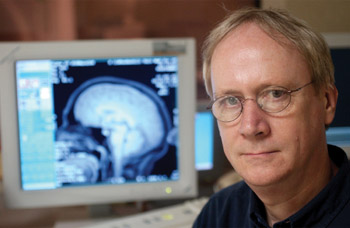
Dr. John Gore, director of the Vanderbilt Institute of Imaging Science, has received the top honor in his field of magnetic resonance imaging. Gore, who came to Vanderbilt in 2002 from Yale University, is developing a transinstitutional research program that recently received two major government grants. Photo by Dana Johnson
Gore recognized; Imaging Institute reaches next level
He was there for its birth, there for its major first steps, and there for its progress thus far. Now, John Gore, Ph.D., director of the Vanderbilt University Institute of Imaging Science, is being recognized for his impact on the life of magnetic resonance imaging (MRI).
Gore has been awarded the Gold Medal of the International Society for Magnetic Resonance in Medicine, the highest honor from the leading organization in the field.
“It’s an honor to be nominated and recognized by my peers,” Gore said. “I’m accepting this award with the knowledge that it also honors all of those who have worked with me and who have contributed their efforts over the years.”
The Gold Medal is awarded to those who have made major research contributions to the field of magnetic resonance in medicine, biology and related fields. Gore will be presented with the award in Kyoto, Japan on May 17 at the Society’s annual meeting.
“Dr. Gore has made numerous contributions to the field of MRI over the past decades, both as a principal investigator as well as a mentor for junior faculty and students. I can think of no one more deserving to be this year’s recipient of the ISMRM Gold Medal,” said Dr. Martin Sandler, Carol D. and Henry P. Pendergrass professor and chair of Radiology and Radiological Sciences.
Since the inception of MRI in the late 1970s, Gore has been a fundamental force in the advancement of the science. Gore was the physicist in charge and helped design the first human system installed in a clinical setting, at Hammersmith Hospital, London. He also performed the first MRI studies to show the effects of particular white matter diseases, and the first studies to exploit MRI contrast agents, using dyes in living animals and showing their imaging effects. Gore also has been developing and understanding methods of functional MRI (fMRI) for more than 10 years.
Gore continues to push the frontiers of MRI. After 20 years on the faculty at Yale University, Gore joined the faculty at Vanderbilt as the director of the new Institute of Imaging Science in July 2002, bringing a team of more than a dozen former Yale scientists with him. The transinstitutional initiative brings together engineers and scientists whose interests span the spectrum of imaging research.
Since its formation, the Institute of Imaging Science has made good progress, according to Gore.
“We’ve gradually developed a structure and grown, building up our core staff and forming collaborative relationships,” he said. “We’re advancing the basic science of medical imaging and working with others on clinical research goals.”
The institute has been recognized for its transinstitutional approach to imaging. It recently received a $4 million National Center for Research Resources (NCRR) building construction grant to create a space that will bring the currently separate elements of the institute together under one roof.
The new space will also house a major new piece of equipment that’s expected to arrive in two years—a 7 tesla human MRI scanner. A tesla is a unit of magnetic field strength. One tesla is roughly 20,000 times the strength of the magnetic field of the earth.
“While most clinical MRI systems now are 1.5 tesla, this stronger system will allow for new kinds of measurement and higher quality imaging,” Gore said.
Gore and his team have already opened the Center for Small Animal Imaging. Housed in F-1200 MCN, the facility provides various imaging resources for studying small animals, such as MRI, X-ray CT, optical and nuclear imaging techniques.
The institute has also received a National Institutes of Health (NIH) Institutional Training Program grant that will help the researchers take advantage of the expanded facilities and additional equipment.
“The grant will allow us to recruit eight new fellows—biologists, physicists, and engineers—and train them to use MRI in new ways,” Gore said. “It’s one of the first institutional training grants awarded by the National Institute of Biomedical Imaging and Bioengineering, and it will allow us to expand our collaborative efforts.”
The researchers are also pursuing collaborations with other investigators on campus. The NIH grant will allow Gore to recruit fellows who could work on collaborative projects.
“For example, if we are teaming up with an investigator to study brain tumors, we’ll work to recruit a fellow who’s interested in both oncology and learning to use MRI,” Gore said. “The fellow could then work in both labs.
“We want other researchers to come and talk to us about the possible role of imaging in their research,” Gore said. “If we can organize various imaging efforts and maintain scientific productivity, we will challenge the very best places in the world.”













